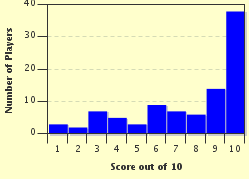Quiz Answer Key and Fun Facts
1. After refusing to consider some cases suggested by Hastings, including a bank clerk who had disappeared along with a small fortune in securities, Poirot indulged Mrs Todd when she insisted that he locate her cook, who had walked out of her job a few days earlier, and sent for her trunk the same day. In his explanation of the case, Poirot revealed that the missing trunk had been used to store the bank clerk's body. In which episode was this macabre announcement made?
2. Hearing of a man who walked out of his house and simply disappeared into thin air (or rather, into the fog), Poirot made a bet with Japp that he could solve the case within a week, without leaving his apartment, as long as he could get the answers to any questions he might pose. After ascertaining that the missing banker and his wife slept in separate rooms, he advised his colleagues to take any money they had invested in that bank out as quickly as possible, since it was about to collapse. In his subsequent explanation, he revealed that the missing man was in the local jail under an assumed identity, ready to start a new life. In which episode did this occur?
3. Shortly before her death, Miss Amelia Barrowby contacted Poirot to ask for his help in a delicate matter. As she died before further communication could be made, he visited her house to see for himself what was going on, admiring the shells decorating the garden beds on his way in. The local police informed him that she had died of strychnine poisoning, but couldn't identify the source, as the other members of the family had all eaten the same meal. Poirot revealed that Miss Barrowby had been fed poisoned oysters by her niece in which of these episodes?
4. In one of Agatha Christie's patented closed-set mysteries, a moneylender-cum-blackmailer is found dead, poisoned by a poison-tipped dart. Many of her fellow passengers had good reason to wish her dead, but Poirot revealed that the murder was committed by the dentist, who had posed as an air steward to move unnoticed past the other passengers. In which episode did Poirot establish that it was Norman Gale who had murdered Madame Giselle?
5. When Count Foscatini was found murdered, suspicion originally fell on Count Ascanio, who had visited Foscatini the previous morning along with another young man. According to Graves, Foscatini's valet, threats had been uttered, and Ascanio was expected for dinner while Graves was out, having been given the night off by his employer. Poirot revealed that the dead man was a blackmailer who had been murdered by his valet, who then attempted to eat all three of the dinners ordered for the fictitious dinner party. In which episode did we discover that Miss Lemon had been dating a murderer?
6. Poirot had been 'sentenced' to two weeks at the Sandy Cove hotel where he was undergoing a health regime supervised by Hastings, but found the tedium alleviated by those around him: Arlena Stuart, an actress; her husband Kenneth Marshall and sullen teenage stepson Lionel Marshall; Patrick Redfern, who appeared to be having an affair with Arlena; Christine Redfern, his clearly furious wife; Emily Brewster, a spinster who became a key witness, and Stephen Lane, a vicar who described Arlena as the embodiment of evil. When Arlena was found strangled on the beach, there was no shortage of suspects, but Poirot untangled the complex web. As he explained the motive and method of the murder, he pointed out the critical fact that the woman Patrick and Emily saw on the beach was Christine disguised as Arlena. In which episode does this complex deception occur?
7. Shortly after Louise Leidner, wife of archeologist Erich Leidner in charge of a dig in Iraq, confided to Poirot that she was receiving threatening letters, she was found dead. In which episode did Poirot reveal that Eric Leidner was really Frederick Bosner, Louise's first husband and her murderer, as well as unveiling the forger and thief of valuable archaeological artifacts, "Father Lavigny"?
8. Linnet Doyle was found dead in her stateroom, and possible suspects included her husband Simon, whose alibi was provided by an earlier incident in which he had been shot by Jackie, formerly his fiancee and Linnet's best friend. Poirot revealed that the red nail polish in Linnet's cabin was really red ink, which Simon had used to pretend to be injured in a staged scene, so that he and Jackie could complete their scheme to obtain Linnet's money and live together happily ever after. In which episode did he also reveal that the maid Louise had been killed because she saw Simon, and attempted to blackmail him?
9. Hercule Poirot and Ariadne Oliver were two of the eight members of a bridge party at which their host, Mr Shaitana, was stabbed through the heart. In which episode did Poirot rely on the psychology of the game to state that Mr Shaitana had been murdered by the dummy while a grand slam was being played?
10. Mr Ratchett had been stabbed twelve times, and, as usual, there was a limited field of suspects. In which episode did Poirot reveal that they all did it?
Source: Author
looney_tunes
This quiz was reviewed by FunTrivia editor
guitargoddess before going online.
Any errors found in FunTrivia content are routinely corrected through our feedback system.

